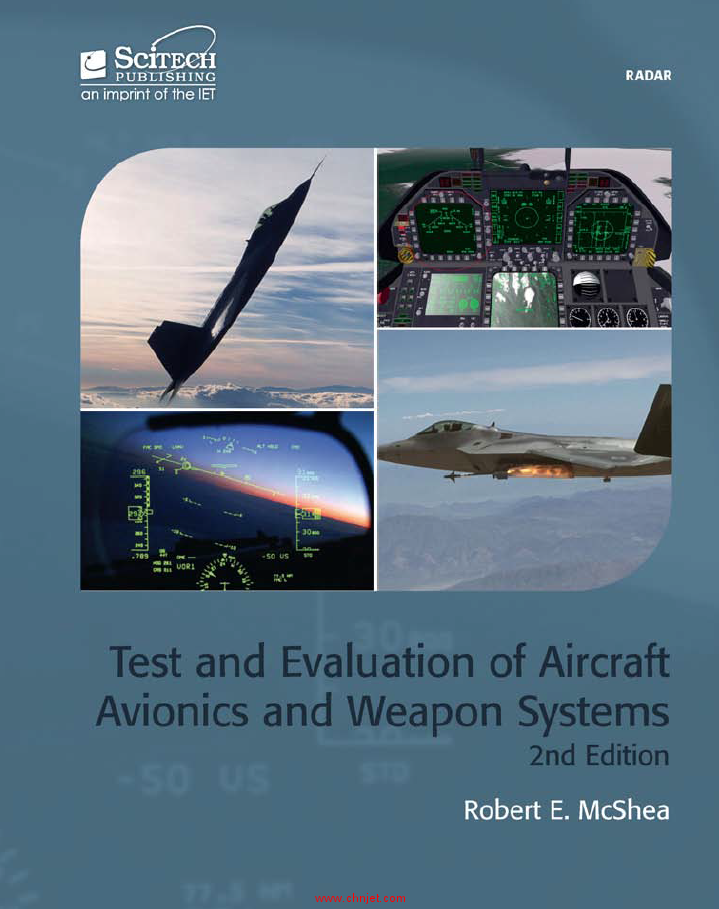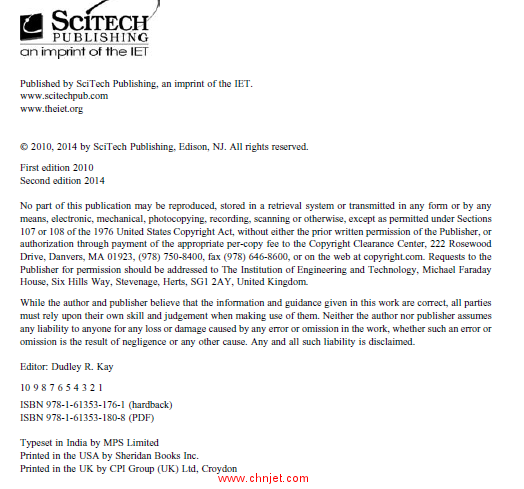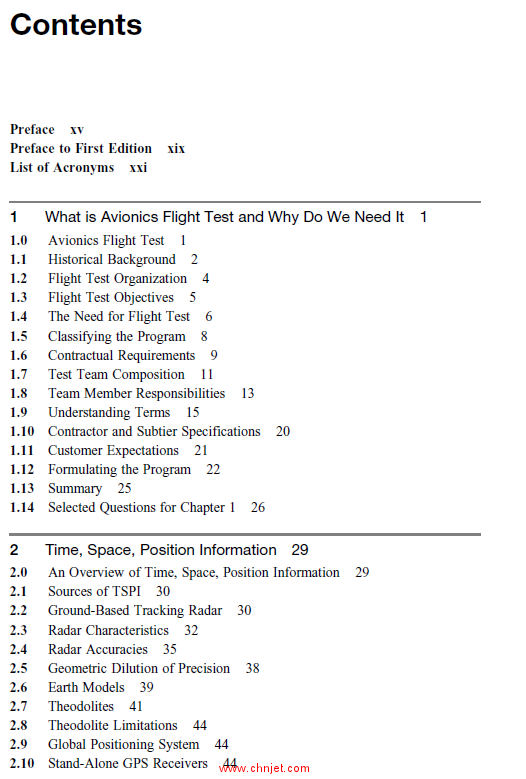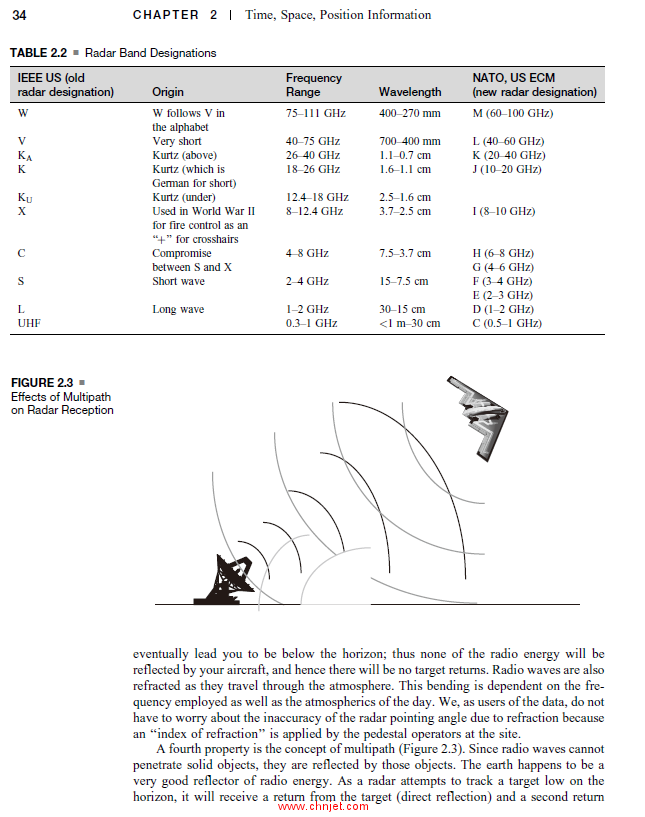马上注册,结交更多好友,享用更多功能,让你轻松玩转社区。
您需要 登录 才可以下载或查看,没有账号?立即注册

×
《Test and Evaluation of Aircraft Avionics and Weapon Systems》第二版
航空电子设备和武器系统试验与评估
作者:Robert E. McShea
出版社:SciTech
出版时间:2014年
《Test and Evaluation of Aircraft Avionics and Weapon Systems》第二版

《Test and Evaluation of Aircraft Avionics and Weapon Systems》第二版

《Test and Evaluation of Aircraft Avionics and Weapon Systems》第二版

《Test and Evaluation of Aircraft Avionics and Weapon Systems》第二版

目录
Preface xv
Preface to First Edition xix
List of Acronyms xxi
1 What is Avionics Flight Test and Why Do We Need It 1
1.0 Avionics Flight Test 1
1.1 Historical Background 2
1.2 Flight Test Organization 4
1.3 Flight Test Objectives 5
1.4 The Need for Flight Test 6
1.5 Classifying the Program 8
1.6 Contractual Requirements 9
1.7 Test Team Composition 11
1.8 Team Member Responsibilities 13
1.9 Understanding Terms 15
1.10 Contractor and Subtier Specifications 20
1.11 Customer Expectations 21
1.12 Formulating the Program 22
1.13 Summary 25
1.14 Selected Questions for Chapter 1 26
2 Time, Space, Position Information 29
2.0 An Overview of Time, Space, Position Information 29
2.1 Sources of TSPI 30
2.2 Ground-Based Tracking Radar 30
2.3 Radar Characteristics 32
2.4 Radar Accuracies 35
2.5 Geometric Dilution of Precision 38
2.6 Earth Models 39
2.7 Theodolites 41
2.8 Theodolite Limitations 44
2.9 Global Positioning System 44
2.10 Stand-Alone GPS Receivers 44
vii
2.11 Inertial-Aided GPS Receivers 46
2.12 Differentially Corrected GPS 48
2.13 Sensor Fusion 48
2.14 Ranges 49
2.15 Range Assets 49
2.16 Unique Services 50
2.17 Interfacing with the Range 51
2.18 Time Alignment 53
2.19 Summary 55
2.20 Exercises 55
2.21 Answers to Exercises 55
2.22 Selected Questions for Chapter 2 58
3 MIL-STD-1553 and Digital Data Busses: Data Reduction
and Analysis 61
3.0 Overview 61
3.1 Historical Background 62
3.2 1553 System Architecture 62
3.3 A Bit About Bits 65
3.4 1553 Word Types 67
3.5 Data Encoding 67
3.6 Word Formats 68
3.7 Command Words 68
3.8 Anomalous Command Word Conditions 70
3.9 Command Word Summary 71
3.10 Status Words 71
3.11 Data Words 73
3.12 Message Contents 74
3.13 Bus Controller Design 75
3.14 Sample Bus Configurations 76
3.15 The Flight Tester’s Task 79
3.16 MIL-STD-1553 Summary 80
3.17 Other Data Busses 81
3.18 Potential Problems for the Analyst 122
3.19 Data Acquisition, Reduction, and Analysis 124
3.20 Selected Questions for Chapter 3 136
4 Communications Flight Test 139
4.0 Overview 139
4.1 Communications Basics 140
viii Contents
4.2 Aircraft Communications Equipment 142
4.3 Test Requirements 144
4.4 The Three Steps in Avionics Testing 144
4.5 Communications Test Plan Matrix 146
4.6 Executing the Matrix 148
4.7 Other Considerations in Communications Tests 149
4.8 Effects of Stores, Landing Gear, and Flaps 149
4.9 Effects of Weather 149
4.10 Logistics 150
4.11 Boredom 151
4.12 Speech Intelligibility 151
4.13 Electromagnetic Interference/Electromagnetic Compatibility 154
4.14 EMI/EMC Testing 158
4.15 EMI/EMC Test Issues 161
4.16 EMI/EMC Elimination 161
4.17 Selected Questions for Chapter 4 164
5 Navigation Systems 167
5.0 Introduction 167
5.1 History 168
5.2 Basic Navigation 168
5.3 Radio Aids to Navigation 175
5.4 Radio Aids to Navigation Testing 184
5.5 Inertial Navigation Systems 191
5.6 Doppler Navigation Systems 207
5.7 Global Navigation Satellite Systems (GNSS) 213
5.8 Identification Friend or Foe 234
5.9 Data Links 238
5.10 Selected Questions for Chapter 5 259
6 Part 23/25/27/29 Avionics Civil Certifications 267
6.0 Introduction 267
6.1 FAA Type Certification History 268
6.2 Federal Aviation Regulations in the Code of Federal Regulations 270
6.3 Other Rules and Guidance 273
6.4 FAA Type Certification Process 274
6.5 Avionics Software Considerations in the Technical Standard Order
Process 282
6.6 Certification Considerations for Highly Integrated or Complex
Systems 285
Contents ix
6.7 Important Notes for Evaluators Concerning Documentation 298
6.8 Differences between EASA and FAA Documentation 300
6.9 Cockpit Controls and Displays Evaluations 301
6.10 Weather RADAR Certification 322
6.11 Airworthiness Approval of Positioning and Navigation Systems 329
6.12 Reduced Vertical Separation Minimums 348
6.13 Proximity Warning Systems 356
6.14 Terrain Awareness and Warning System 382
6.15 Flight Guidance Systems 410
6.16 Landing Systems 459
6.17 Flight Management Systems 504
6.18 Enhanced Vision Systems (EVS) 520
6.19 Summary 527
6.20 Selected Questions for Chapter 6 528
7 Electro-optical and Infrared Systems 535
7.0 Introduction 535
7.1 Infrared History 536
7.2 IR Radiation Fundamentals 547
7.3 IR Sources 552
7.4 The Thermal Process 554
7.5 Atmospheric Propagation of Radiation 556
7.6 Target Signatures 562
7.7 EO Components and Performance Requirements 567
7.8 Passive EO Devices 581
7.9 Laser Systems 588
7.10 Passive EO Flight Test Evaluations 594
7.11 Active EO Systems 614
7.12 Selected Questions for Chapter 7 618
8 Radio Detection and Ranging – Radar 625
8.0 Introduction 625
8.1 Understanding Radar 626
8.2 Performance Considerations 629
8.3 Radar Utility 630
8.4 Radar Detections 636
8.5 Maximum Radar Detection 641
8.6 Radar Sample Applications 645
8.7 Pulse Delay Ranging Radar Modes of Operation and Testing 652
x Contents
8.8 Doppler and Pulse Doppler Modes of Operation and Testing 668
8.9 Air-to-Ground Radar 694
8.10 Millimetric Wave Radar 710
8.11 Miscellaneous Modes of Radar 712
8.12 Some Final Considerations in Radar Testing 712
8.13 Selected Questions for Chapter 8 714
9 Electronic Warfare 719
9.0 Introduction 719
9.1 Electronic Warfare Overview 720
9.2 The Threat 724
9.3 Air Defense Systems 728
9.4 Electronic Attack 729
9.5 Noise Jamming 734
9.6 Deception Jamming 738
9.7 Chaff Employment 742
9.8 Flare Employment 743
9.9 Electronic Protection Measures 745
9.10 Electronic Warfare Systems Test and Evaluation 748
9.11 Finally 760
9.12 Selected Questions for Chapter 9 760
10 Air-to-Air/Air-to-Ground Weapons Integration 763
10.0 Introduction 763
10.1 Weapons Overview 764
10.2 Stores Management System 767
10.3 Air-to-Air Missiles 785
10.4 Air-to-Ground Weapons 803
10.5 MIL-HDBK-1763 Test Requirements 812
10.6 AGARD Flight Test Techniques Series, Volume 10 Requirements 820
10.7 Weapons Delivery Considerations for Helicopters 824
10.8 Selected Questions for Chapter 10 828
11 A Typical Avionics Integration Flight Test Program 831
11.0 Introduction 831
11.1 Vehicle Test Requirements 831
11.2 Avionics Test Requirements 833
11.3 Test Planning 835
Contents xi
11.4 Responsibilities of the Test Team 843
11.5 Analysis and Reporting 848
11.6 Selected Questions for Chapter 11 849
12 Unmanned Aerial Vehicles (UAV) 851
12.0 Introduction 851
12.1 UAV Types 852
12.2 Interoperability 856
12.3 The Airworthiness Certificate 857
12.4 UAS Communications Architecture 860
12.5 Navigation 886
12.6 Autopilots 889
12.7 Sense and Avoid Systems 892
12.8 Payload 899
12.9 Optionally Piloted Aircraft (OPA) 901
12.10 Summary 902
12.11 Selected Questions for Chapter 12 902
13 Night Vision Imaging Systems (NVIS) and Helmet
Mounted Displays (HMD) 907
13.0 Introduction 907
13.1 Overview 908
13.2 Image Intensification (I2) Technology 909
13.3 NVG Human Factors Issues 918
13.4 Lighting Specifications 920
13.5 Interior NVIS Lighting Methods 924
13.6 Exterior Lighting Methods 929
13.7 Test and Evaluation of NVIS Equipment 931
13.8 Some Final Considerations 938
13.9 Helmet Mounted Display Systems (HMD) 939
13.10 HMD Components 942
13.11 Test and Evaluation of HMD Equipment 949
13.12 Selected Questions for Chapter 13 954
14 Acquisition, Test Management, and Operational Test
and Evaluation 957
14.0 Overview 957
14.1 Applicable Documentation 958
xii Contents
14.2 The Acquisition Process 958
14.3 The Operational Requirements Document (ORD) 965
14.4 The Test and Evaluation Master Plan (TEMP) 966
14.5 Operational Test and Evaluation 967
14.6 OT&E Test Plan Structure 970
14.7 Reliability, Maintainability, Logistics Supportability,
and Availability (RML&A) 978
14.8 Summary 981
14.9 Selected Questions for Chapter 14 981
Index 983
专业书籍
下载地址:(回复后可见)
| ![]()